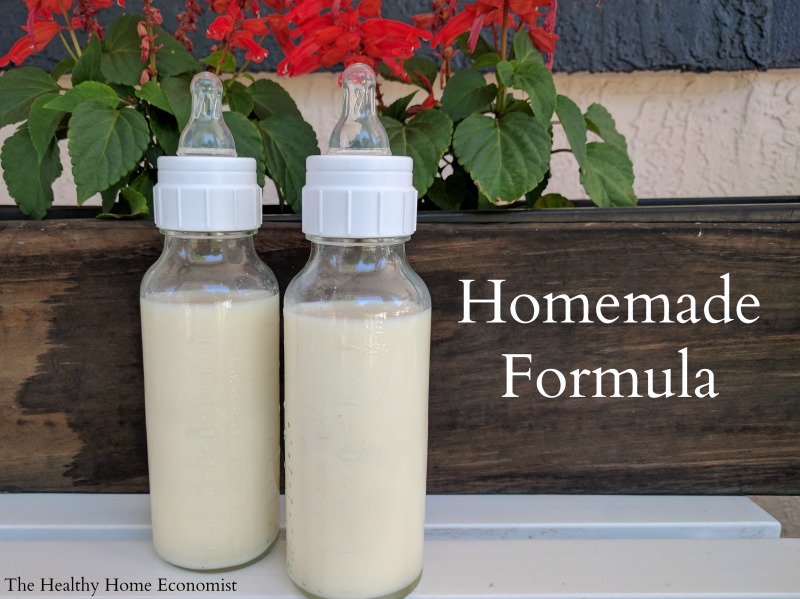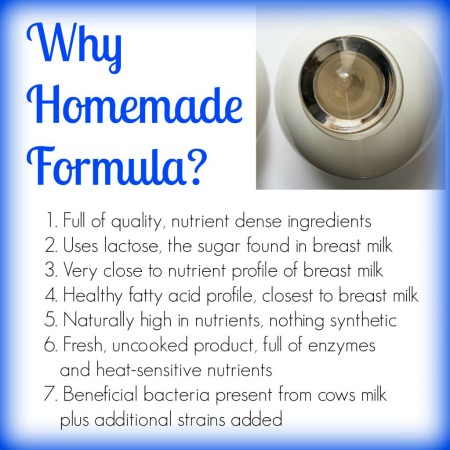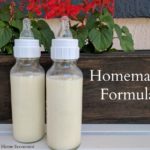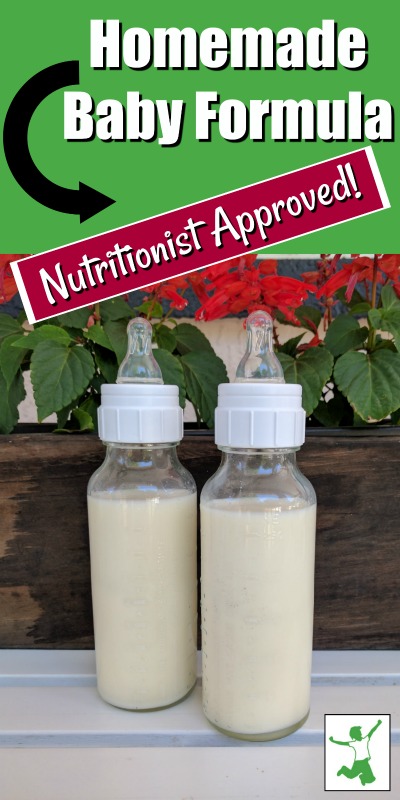Table of Contents[Hide][Show]
A nourishing homemade baby formula using safe, whole ingredients. This recipe was developed and tested by Dr. Mary Enig, a PhD Nutritionist and originally published in Nourishing Traditions cookbook in 1996. It was formulated to match breastmilk as closely as possible and is also suitable for infants. Source: Weston A. Price Foundation

There is no doubt that breastfeeding your baby is the best option for the child’s long-term health and development. Human breastmilk from a well-nourished mother is the perfect food for baby. However, in circumstances where the child is adopted or the Mother finds herself unable to breastfeed, formula feeding becomes necessary. In those cases, homemade baby formula is best.
Using a baby formula recipe that closely matches the nutritional profile of breastmilk is a far better choice than even organic baby formula from the health food store. More on this below.
Note: Donor programs are widely available for human breastmilk. But, the diets of the donor mothers are unknown and most likely nutritionally insufficient. In addition, breastmilk banks pasteurize the donated breastmilk which destroys much of the nutritional benefit. Unless you are fortunate to have a trusted and direct donor milk source in your community, avoid this option!
Dangers of Commercial Formula
Commercial formulas are always a poor choice for a number of reasons. First of all, formula manufacturers line the cans with the chemical BPA. This substance disrupts hormone development and is a probable contributor to early puberty in girls, and ADHD, urogenital abnormalities, and other ills in boys.
The European Food Safety Authority found that canned commercial formula is a significant source of BPA for infants, exposing the child to 13mcg of BPA per kg of body weight per day! BPA-free formula cans are no better. The chemical BPS is typically used instead which is just as dangerous.
Beware that manufacturers pack even organic commercial formula like Earth’s Best in BPA cans. Worse, they use organic brown rice syrup as the primary sweetener which is known to be frequently contaminated with arsenic.
In addition, all commercial milk formulas are processed at extremely high temperatures which violently denature the fragile milk proteins, render them allergenic, and add carcinogens to the final product. Soy infant formula is the worst. Obscenely high processing temperatures not only denature the proteins but large levels of phytic acid in soy block mineral absorption by the infant. Moreover, soy-based plant estrogens disrupt the hormonal development of the baby!
It seems that for the concerned Mother who is unable to breastfeed, learning how to make baby formula at home with safe, pure ingredients is the most prudent way to go!
Why Make Homemade Formula Even if You Are Breastfeeding
In the video below, I show you how to make your own safe, healthy raw milk homemade formula for your baby.
The recipe I follow was originally published in the cookbook Nourishing Traditions in 1996 and developed by Dr. Mary Enig.
Even though I breastfed each of my children for at least 2 years, I made this exact formula for my own children when I was away for the day or the evening as pumping was not an option that worked well for me.
I even used this homemade formula for an entire day once when I had some dental work done and was advised to pump and discard for 24 hours.
As a result, even successfully breastfeeding Moms can use this wonderful homemade formula as a supplement when necessary to their own nutrient-dense breastmilk!
It is advised that even breastfeeding Mothers have the ingredients for this formula on hand for an emergency. If Mom is sick or otherwise unable to nurse, Dad can step in and make this safe alternative until Mom is back on her feet. It takes a few days to a week to gather all the ingredients together to make this formula, which is why I advise having them on hand at all times.
Homemade Most Nutritious
The image below lists the reasons why it is worth it nutritionally to make formula yourself for your precious baby!
You can order all of the required ingredients for the homemade baby formula in one package from this reputable, vetted source.
Moms who have successfully used this formula feeding your children, please post about your experience in the comments section to encourage those who are considering it and need some Mom to Mom encouragement!

Where to Source Quality Milk
The most widely available grass-fed milk around the world is from cows. This is usually the most budget-friendly and easily sourced milk for this recipe for homemade formula.
If only goat milk is available in your area, this recipe for goat milk baby formula can be used instead. When using milk from ewes, please refer to the linked article for an adjusted recipe; one of the benefits of sheep milk is that it is higher in healthy fats than either goat or cow milk.
Camel milk formula is another option that is a particularly digestible form of dairy and growing in popularity around the world.
Alternatively, you can use low temp (vat) pasteurized, non-homogenized whole milk cultured with a piima or kefir starter. Then substitute the piima milk or kefir for the raw milk portion of the formula recipe. Cold-pressed raw milk also must be cultured before using it as it contains no probiotics.
Do NOT use ultrapasteurized (UHT) milk even if organic as it is too highly processed and extremely allergenic!
It is also best to avoid all types of powdered milk for this recipe. The factory process of making milk powder reduces nutrition considerably and denatures it, which makes it more likely baby will have an allergic reaction.
Dairy Allergy Option
If all types of dairy prove unsuitable for your baby, make this nondairy baby formula recipe instead. It uses a base of homemade bone broth as a substitute for milk. It is important not to utilize a plant-based or otherwise vegan baby formula recipe.
Avoid buying bone broth to make the dairy-free formula. Make it yourself! Manufacturers of commercial bone broth, even if authentic, may water down the end product. This is apparent if it does not gel when chilled in the refrigerator.
Many brands have toxic packaging issues as well. If you must buy it in a pinch, see my shopping guide page for vetted brands that are safe.

Homemade Baby Formula Recipe (for infants too)
A nourishing baby formula recipe you can make at home with safe, whole ingredients developed and tested by a PhD nutritionist to match breastmilk as closely as possible. Also suitable for infants.
Ingredients
- 2 cups raw cow milk OR organic whole milk yogurt
- 1 7/8 cups filtered water
- 1/4 cup liquid whey
- 4 Tbl lactose
- 1/4 tsp Bifidobacterium infantis powder
- 2-4 Tbl raw or pasteurized cream
- 1/2 tsp cod liver oil unflavored
- 1/4 tsp butter oil unflavored
- 1 tsp sunflower oil preferably organic
- 1 tsp extra virgin olive oil preferably organic
- 2 tsp virgin coconut oil preferably organic
- 2 tsp nutritional yeast
- 2 tsp gelatin
- 1/4 tsp acerola powder
Instructions
-
Fill a 2 cup Pyrex measuring cup with filtered water and remove 2 TBL (this will give you 1 7/8 cup water).
-
Pour about half the water into a pan and turn burner on medium.
-
Add the gelatin and lactose and let dissolve, stirring occasionally.
-
When gelatin and lactose are dissolved, remove pan from heat and add the rest of the water to cool.
-
Stir in the coconut oil and butter oil until melted.
-
Put remaining ingredients in a glass blender.
-
Add the water mixture and blend for about 3 seconds.
-
Place formula in glass baby bottles or a glass jar and refrigerate.
-
Before giving to baby, warm glass bottle in a pan of hot water or a bottle warmer. NEVER microwave baby bottles!
Recipe Video
Recipe Notes
If using raw cow milk from holstein cows, use 4 Tbl of extra cream (otherwise use 2 Tbl extra cream).
If choosing to make this homemade formula with camel milk, be sure to include 4 Tbl extra cream as camel milk is lower in cream than cow milk.
Do not use high oleic sunflower oil. Use only the brand recommended in the ingredients list which is cold pressed, organic, unrefined, and low oleic.
*Do NOT use powdered whey from the store as it is denatured. Avoid whey from making cheese as it will curdle the formula.
*Do not substitute pasteurized or powdered milk as these are heavily processed, denatured and allergenic foods.
*Do NOT use ultrapasteurized (UHT) cream. It is highly allergenic. Raw or pasteurized cream is acceptable.
*Do NOT use fish oil or krill oil instead of high vitamin cod liver oil as they do not contain any Vitamin D and very little to no Vitamin A.
Collagen powder may be substituted for the gelatin in a pinch (more on peptides in baby formula in this article).
If you are wondering where is the iron in homemade baby formula, this article provides an explanation.
If baby experiences constipation using this formula, try adding 1 tsp of molasses to each batch. This should help move things along.
How to Transition to DIY Formula
Once you’ve viewed the video, gathered the ingredients, and made your first batch, how do you feed it to your baby for the first time?
It is important not to switch all at once as this can cause gas, excessive spit-up, or an uncomfortable change in diaper habits such as constipation or overly loose stools.
Start by giving your baby three-quarters of the old formula blended with one-quarter of the homemade. Try this ratio for a day or two and see how your infant responds.
If no digestive upset or major change in diaper habits occurs, increase the amount to a 50-50 blend of old formula to homemade. Observe for another day or two as before.
If no major issues, increase once again to three-quarters homemade formula to one-quarter old formula. If baby does well on this blend for a third time, you are ready to fully transition to the homemade formula.
At any time during the transition, symptoms of intolerance emerge, back up to the previous successful blend ratio and stay there for a day or two before attempting to increase once again.
Homemade Formula FAQ
Weston Price Foundation
Feeding an Adopted Baby
Traveling Tips with Baby Formula Made at Home
Iron in Baby Formula
Collagen Peptides instead of Gelatin for Homemade Formula?










Could you please clarify? How can I know it is safe if cultured? I’m not sure I’m understanding correctly. Could you suggest any data/scientific journals that show this?
If raw milk is contaminated with pathogens, it won’t culture with beneficial cultures into yogurt or kefir. That is the basics of fermentation.
Hello, just one more question concerning the 24 cultures yogurt from raw milk? You mentioned that this may be an alternative to using raw milk, but is the temperature (106-117) high enough to kill any potentially harmful bacteria? I read that milk must be cooked at 145-161 degrees to kill any bacteria. What would be the benefit of using this yogurt as opposed to the milk if the bacteria would not be killed?
The fact that the raw milk cultured in the first place is indicative that it is safe.
Can a 4 month old baby begin drinking this formula? I always heard that cows milk wasn’t good to start giving a baby before they turned 1?
Pasteurized cow milk is not a good thing for children to have as it is very allergenic. Grassfed raw milk is very different and most babies do very well with it. This recipe was designed by a PhD nutritionist and yes, it is for babies from birth through age 1.
Can you tell me days can be stored in fridge and if can be pre made and frozen? If so storage on that too.
1-2 days in the fridge (best made fresh everyday if possible. If you won’t use a whole batch in one or two days, make half batches instead). If freezing, a few weeks is fine. Use breastmilk freezer bags to freeze individual servings.
Thank you! What is 24 hour whole milk yogurt?
24 hour yogurt is yogurt that is cultured for a full 24 hours. https://www.thehealthyhomeeconomist.com/raw-yogurt-made-in-the-microwave/
Hello, should I be concerned about the lack of bacterial clearance since the milk is not pasteurized?
Of course, be sure to source from a clean dairy that tests its milk. That said, raw milk is quite safe despite the propaganda that Big Dairy puts out to scare people away. https://www.thehealthyhomeeconomist.com/government-data-proves-raw-milk-is-safe/
If you are unsure, use 24 hour whole milk yogurt or kefir instead for the milk portion of the recipe.
What is the average cost to make a batch? My almost 3 month old has cows milk protein intolerance and is currently on Nutramigen, which is very expensive. i would love to make a formula for her.
Making homemade formula with quality grassfed milk is not an inexpensive option, but compares favorably to specialty commercial formulas. This from the WAPF whose PhD nutritionist created the formula “The homemade formula ingredients cost just under $4 per day, through mail order with shipping charges, or when purchased locally with sales tax. This does not include the cost of the milk and cream, which varies widely. Similac costs around $4 per day, including average local sales tax. So while the initial homemade formula cost including milk and cream will be higher, over the long run it is much cheaper considering the typical health challenges and costs that come with conventional formula. This, of course, says nothing about creating a superior foundation for your child’s optimal development and lifelong health.”
having access to raw cream is hard and I am bit hesitant to use store bought pasteurized cream. Could I substitute the cream by homemade piima cream ? (Piima cream cultured on the pasteurized cream)
Yes you can use piima cream.
Ok, one more question. I was sooooo anxious to try this that I started making it as soon as I got my raw milk order even though my lactose powder hadn’t arrived yet. I didn’t look carefully at the recipe and thought it was going to be just a small thing missing— now I see it calls for 4 tablespoons of the lactose!!! Is the lactose crucial? If I make a batch without it will it be ok?? If it’s just for sweetness could I put something else in it? Ack!
Lactose is a very important ingredient in the homemade formula because there is much more lactose in human breastmilk than in cow’s milk. It is not just for sweetness … it is actually important developmentally for the digestive and neurological systems as well. Best to wait until the lactose arrives … or get some quickly at your healthfood store. Many carry it now.
My baby was born premature (34 weeks and 5 days) and we stayed in the NICU for 19 days exactly. I didn’t know about tongue tie and nobody in the hospital except one nurse, mentioned it.
I didn’t know why my baby wasn’t gaining weight and I was under a lot of pressure trying to pump the hell out of my breasts….wasn’t producing enough …I guess I needed baby’s stimulation to really produce the numbers!. After a few weeks of this struggle, I decided to bring baby to a craneal child chiropractor who gave us the proper diagnosis of several tongue ties in baby’s mouth. So even though we actually ended up fixing the ties with a specialist (laser procedure) ….I still supplemented. I felt I was behind and very sad. I was very aware of the dangers of store bought baby formula and didn’t want to go that way AT ALL. S found this recipe, which ironically someone sent to me in the past while pregnant and didn’t think I was gonna need it. This humbled me big time! I thanked the Lord for that!
The recipe sounded like a mountain….big project, monumental ….oh my God!!! I was afraid (also first time mom…Mamas!). But I went all the way with this recipe…gathered all the ingredients, watched the Healthy Economist making it video and I don’t regret it for a second. My baby never had stomach issues or reflux…or any stomach abnormalities or allergies ….he gained weight and I he was being norished. Everybody was afraid of the “raw” element …and all the scary stories. I am sharing my personal experience with a premmie baby and how it helped my family. I kept nursing and supplementing through many many months with this wonderful homemade formula. Today he is 19 months old and he drinks raw milk often in smoothies or by itself. He loves it! I still add some oils to the milk especially: coconut oil…cod liver oil and some sunflower oil.
We are a testimony that it works…for those who are little eskeptical or afraid….don’t be !
If you need any other information from my experience let me know.
I love the Healthy Economist!!!! Xoxo God bless you all